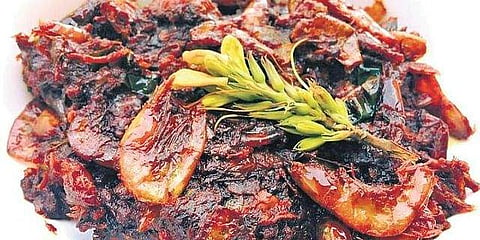
- LIFESTYLE
- FASHION
- FOOD
- ENTERTAINMENT
- EVENTS
- CULTURE
- VIDEOS
- WEB STORIES
- GALLERIES
- GADGETS
- CAR & BIKE
- SOCIETY
- TRAVEL
- NORTH EAST
- INDULGE CONNECT

In Odisha, Sweta Biswal spends her free hours sorting through powdery white Nimba Kadha (neem buds/margosa buds) that sit delicately on their branches. These are used in Pithau Bhaja (a pancake made with rice flour and seasonings) and Nimba Kadha Baigana bhaja (tossed with eggplants and lots of onions). “Consumption of these buds and flowers is a ritual in the Hindu month of Chaitra.
It is said to cleanse the blood and increase immunity to fight off diseases like measles and chickenpox that occur during this season. As it is supposed to be consumed every day during the month, a handful of the buds are added to various kinds of bhaja. A particularly interesting one is made by tossing the buds in mustard oil with onions and sundried tomatoes called Sula. Since it is quite short-lived, Nimba Kadha is also sundried and used to season kanji, a sweet-sour soup-like preparation, during the summer months,” says Biswal.
Chaitra began earlier in April with Gudi Padwa and Ugadi. In certain states in South India, devotees make an offering called Ugadi Pachadi (chutney), to be consumed first thing in the morning on an empty stomach. Homemaker Vandana Kareti explains, “It is made with sour mango, sweet jaggery, spicy chilli and bitter-tasting neem flowers.
This is symbolic and serves as a reminder to take in the unpleasant with the soothing.” Urvi Zanzmera, a food blogger from Surat with Kathiawadi roots, has vivid memories of her father asking her to pluck some jasood na ful (hibiscus flowers) or Gulmohar to make a simple bhaji. “He would wash the petals and saute them in singtel (groundnut oil) with lots of garlic. I remember not liking it but it was eaten for seasonal healing,” says Zanzmera.
Honeysuckle and Elderflower may be all the rage in gourmet drinks and hipster salads; however, Indians have been consuming flowers, not just as garnishing, but sautéed and stir-fried as well. Creative and sophisticated uses have been mentioned in our ancient texts like Lokapakara, Ni’matnama and Supa Shastra. Mumbai’s Alka Keswani who runs popular blog SindhiRasoi.com talks about Suhanjare ja gulah—moringa flowers that are consumed as a dry sabzi, in form of raita and even in curries in Sindhi homes. One is not to get delirious about their sweet fragrance. Alka adds, “These nutritious flowers are generally cooked with tomato or curd to cut the bitterness.”
Delhi-based Sneha Saikia, home chef and a proponent of Assamese cuisine, tells us, how most flowers are either bitter or astringent and are consumed for health reasons. Bauhinia buds are called tita phool in Assam. “Titan means bitter. These are bitter than neem. But we have a palette for eating bitter. We also add other ingredients so it’s more palatable. It blooms like an orange coloured lavender flower from February to April, which is pollen allergy season.
We consume a small portion of preparations like Tita phool xoite bhoja bhaat (Tita phool fried with leftover rice) or Xukaan Maas aru tita phulor khaar (tita phool khaar with dried shrimps) before our main meal.” One of Saikia’s recent pop-ups was themed Pholur-e-Ekhaz, which means one meal with flowers. Right from starters till dessert, flowers were the showstopper. Some of the dishes were, “Aloo Pitika with Lemon flower; Sojna Phool (drumstick flower ) stir-fried with Duck Eggs (where we don’t parboil it first); Banana Flower with Black Chana or Chicken; Bbokphool Fritters (Agasti is an s-shaped flower, which opens when pinched from the bottom and we stuff it with meat or vegetables); Papaya Flower Khar is cooked with pork,” says Saikia.
In central India, Anuradha Medhora of Charoli foods, a Mumbai-based cloud kitchen specialising in royal Malwa cuisine, mentions the use of Roses, jasmine, water lilies (neel kamal), champa, jujube (ber), trumpet flowers (turbanee ke phool), Palash flowers (tesukaphool) in Royal cuisine of Malwa to create enticing recipes. “While, some are used to brewing spirits or extracting oil, all are believed to have healing properties.”
Up in Kanha National Park, author Sangeeta Khanna is taking enthusiasts on a Mahua trail from April 15-20, in association with Vanasafaris. A sacred tree, and a significant part of gond art, this trail consists of visits to tribal haats and trying mahua-infused meals. Participants also get a taste of mahua jaggery that Khanna has been making. Many flowers are blooming across the country as you read this. Ask around for these underutilised gems and give them a try.
BLOOMING BENEFITS
✥It is believed that eating bitter, and in this case flowers, protects our body from seasonal allergies.
✥Flowers are consumed to keep diseases like measles and chickenpox at bay.
✥Flowers are nutritive and help in increasing immunity.
✥Bahunia are called Nongmangkha in Manipur; these are eaten in a spicy singju with fermented
fish and chillies.
✥Semal buds, called Dhepa, are used in UP in many local dishes. Because of the socio-ethnic importance of the semal tree, many villages like Semari and Semrahana are named after it.
✥ Coral jasmine (har shringar, sheoli, parijaat are its local names) is consumed in Bengal and Assam as pakodas. So is the pumpkin flower. These flowers have medicinal properties. They are also a part of our folklore.